ACCOUNTED FOR
|
NAME Marley Richard Arthurholtz |
NICKNAME — |
SERVICE NUMBER 288660 |
|
| UNIT Marine Detachment USS Oklahoma |
HOME OF RECORD South Bend, IN |
NEXT OF KIN Mother, Mrs. Mary Arthurholtz |
||
| DATE OF BIRTH July 11, 1921 at Indianapolis, IN |
ENTERED SERVICE July 20, 1940 at Chicago, IL |
DATE OF LOSS December 7, 1941 |
||
| REGION Hawaiian Islands |
CAMPAIGN / AREA Pearl Harbor |
CASUALTY TYPE Missing In Action |
||
|
CIRCUMSTANCES OF LOSS PFC Arthurholtz was accounted for on 18 September 2019. |
||||
| INDIVIDUAL DECORATIONS Purple Heart |
LAST KNOWN RANK Private First Class |
STATUS OF REMAINS Accounted For DPAA Announcement |
MEMORIALS St. Joseph Valley Memorial Park, Granger, IN USS Oklahoma Memorial Honolulu Memorial |
|
Marley Richard Athurholtz was born in Indianapolis, Indiana on 11 July 1921. His parents – Mervil (who went by William) and Vitalis (who went by Mary) – relocated to St. Joseph County and settled in Centre Township. William toiled as a salesman and Studebaker factory worker; Mary worked part-time for a dry-cleaning service while raising Marley, Betty, and John. All three kids attended local schools, and Marley played guard for the Lakeville Trojans – a basketball team with more gusto than skill. “They play good ball for three games and then blow sky high,” commented Coach Harold Waddell, “but they’re improving.”
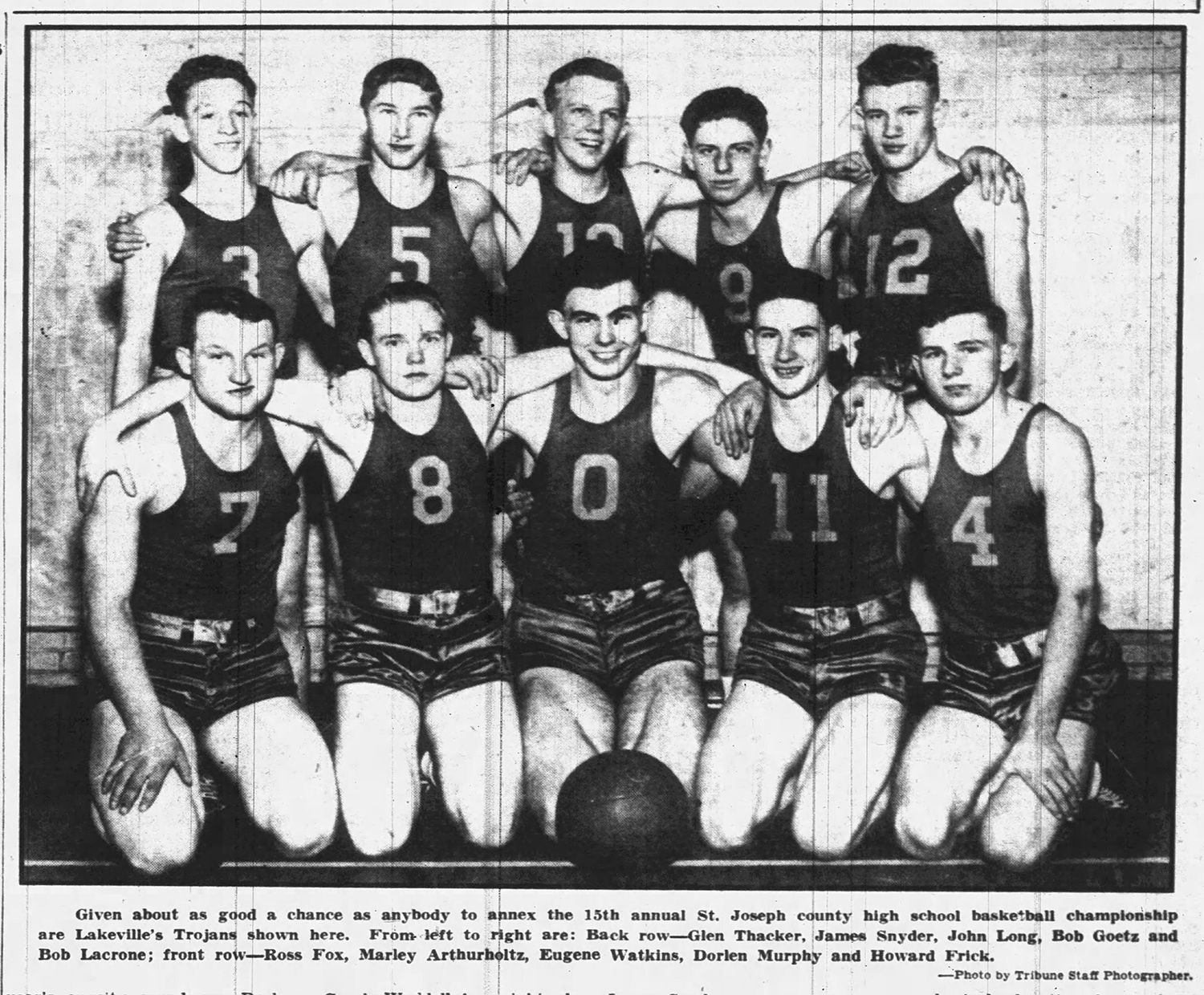
Marley graduated from high school in 1940 and joined the Marine Corps “just as soon as he received his diploma.”[1] He was interested in photography and hoped to bring that passion into the service.[2] Instead, Private Arthurholtz was assigned to Sea School upon completion of boot camp. This was a choice assignment, usually reserved for outstanding trainees of good military bearing – and of imposing stature. It was a good fit for the former basketball player, and after a few weeks of training, Arthurholtz drew another choice assignment. On 8 October 1940, he joined the Marine detachment aboard the battleship USS Oklahoma.
Unfortunately, Arthurholtz’s exact duties are not recorded in the detachment’s muster rolls. Marines acted as the ship’s security force, as orderlies and bodyguards for senior officers, and manned anti-aircraft guns and the heavier five-inch mounts of the battleship’s secondary battery. Whatever his role, Arthurholtz evidently turned to with enthusiasm, for he was promoted to Private First Class in April of 1941.
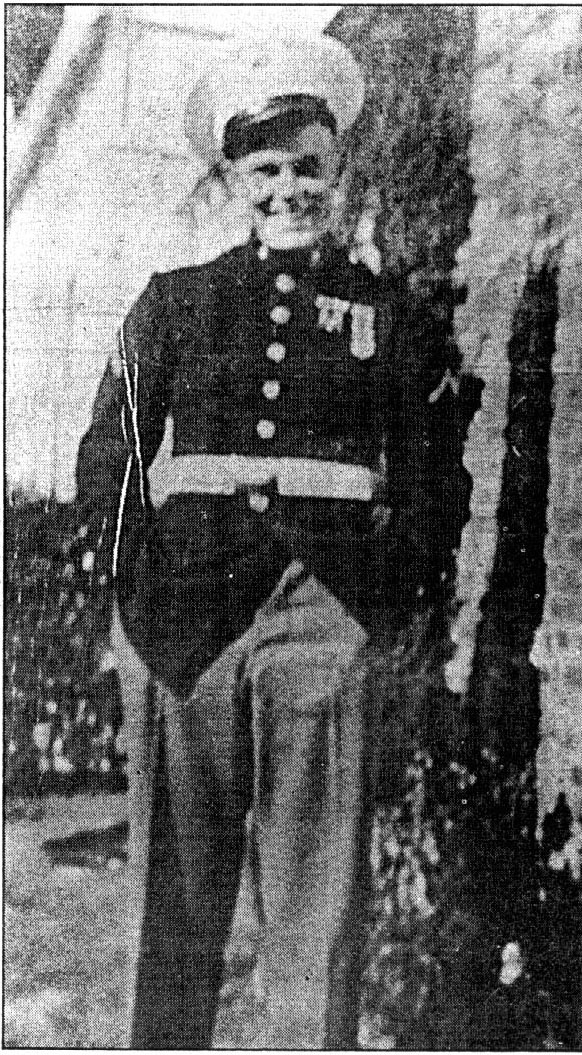 Aside from a refit at Puget Sound Navy Yard, the Oklahoma was almost exclusively in Hawaiian waters during 1941, with most of that time spent in and around Pearl Harbor. It was a dream duty station for a young Marine – plenty of parades and ceremonies, opportunities to wear their beautiful blue dress uniforms, and all the prestige that came along with serving on one of the great fleet battleships. With the famous (or infamous) liberty town of Honolulu close by, Marines could spend their spare time and spare pay on any number of exotic diversions. Some even managed to get furloughs back to the mainland. Marley Arthurholtz appears to have been one – in September of 1941, he took a trip to Carson City, Nevada. This was no mere sightseeing excursion: he was there to get married. Marley and Sue Ann Linscott were wed on 30 September 1941, but their time together must have been brief as Marley was needed back in Hawaii.[3]
Aside from a refit at Puget Sound Navy Yard, the Oklahoma was almost exclusively in Hawaiian waters during 1941, with most of that time spent in and around Pearl Harbor. It was a dream duty station for a young Marine – plenty of parades and ceremonies, opportunities to wear their beautiful blue dress uniforms, and all the prestige that came along with serving on one of the great fleet battleships. With the famous (or infamous) liberty town of Honolulu close by, Marines could spend their spare time and spare pay on any number of exotic diversions. Some even managed to get furloughs back to the mainland. Marley Arthurholtz appears to have been one – in September of 1941, he took a trip to Carson City, Nevada. This was no mere sightseeing excursion: he was there to get married. Marley and Sue Ann Linscott were wed on 30 September 1941, but their time together must have been brief as Marley was needed back in Hawaii.[3]
Saturday, December 6, was a liberty day for half of the Oklahoma’s Marines. PFC Arthurholtz creased his trousers, shined his shoes, and went ashore with one of his buddies, PFC Marlin Seale. The two spent the day sightseeing and shopping and headed back in good season – there was another chance at liberty on Sunday, and neither wanted to wind up on the First Sergeant’s blacklist.
December 7 dawned like any other day at Pearl Harbor. The Marine color guard stood ready on deck to perform the flag raising ceremony, while those off duty began to gather at the rail, impatiently waiting the launch to take them ashore. PFC Seale was down in the Marine quarters. “I was cleaning my canteen because we were going to have a big inspection on Monday,” he said. He hoped to go back ashore once his chores were complete.
Then alarms started to ring, and the big battleship lurched and trembled as the first torpedoes struck amidships. Belowdecks, men looked at each other in confusion, and a few started to head topside. Seale was one of those lucky ones. The ship immediately began to list, and as he cleared the Marine quarters, heavy lockers began to fall from the walls behind him. “If I’d been a half-minute later I would have been trapped when the lockers started to fall over,” said Seale. He emerged into utter chaos: bombs and torpedoes exploding, men running and screaming, and strange aircraft flying overhead. Nearby, the USS Arizona exploded in a giant fireball, taking all of Seale’s sea school classmates with her. A confused officer issued three commands in quick succession: “We are being attacked. Man the anti-aircraft batteries. Abandon ship.”
“And it was over,” Seale concluded. “The Oklahoma rolled over eight minutes after it was hit.”[4]
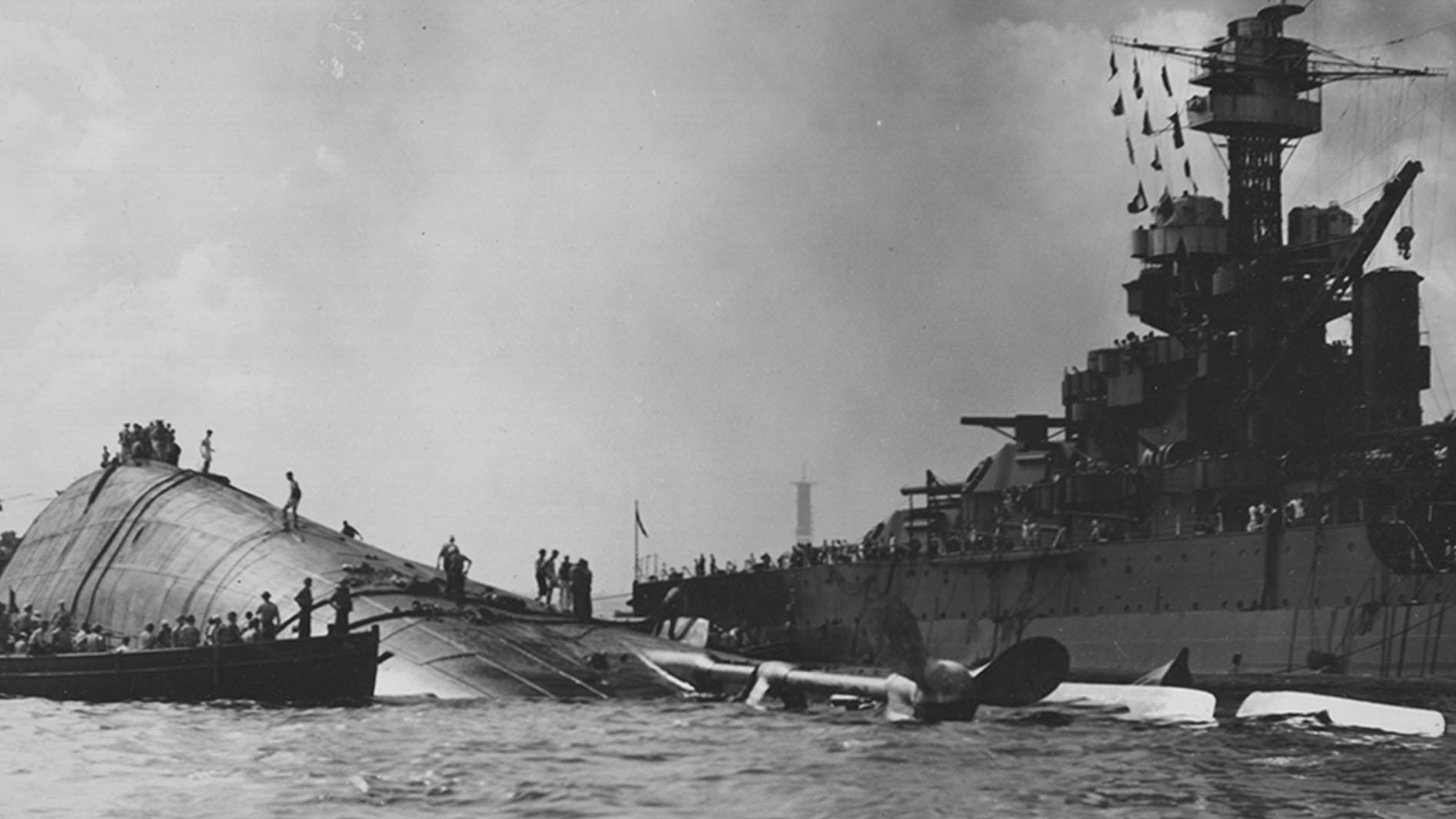
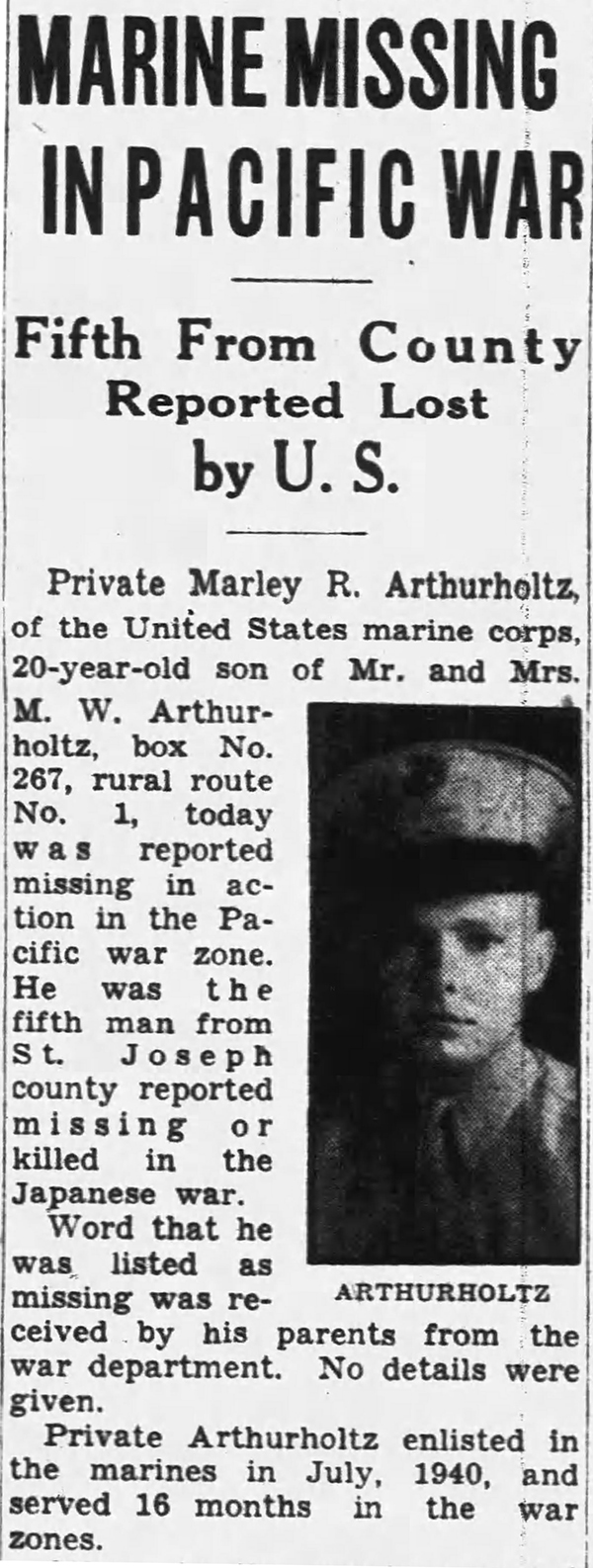
It is not known where and how Marley Arthurholtz met his end. He may have been trapped in the Marine quarters when the ship capsized, killed on his way to his battle station, or hit while he waited for the liberty launch. When the attack was over and officers tried to tally Oklahoma‘s losses, they could find no eyewitnesses to confirm Marley’s death. He was officially listed as missing in action, although most who survived the attack had little doubt that many men so designated were, in fact, dead.
The telegram arrived, with cruel timing, on Christmas Day. Mary refused to believe the news and spent her holiday writing letter after letter to her son, “clinging to the faint thread of hope that somehow her son survived, that somewhere he was alive and fighting on with his comrades.” In January, she received a letter from Captain Richard P. Ross, who had commanded the Oklahoma‘s Marines. “Your son was a fine Marine and a credit to our Corps and to his family,” wrote Ross.
He has been missing in action since the seventh of December and I feel certain that he has given his life to his country. I know that your heart must be broken as I know my own mother’s would if anything should happen to me. But you should also feel proud that you were given the opportunity to make the sacrifice for our country. I know that Marley would want you to feel this way. He has given his life voluntarily and bravely in defense of those principles for which America stands and which, God willing, we will defend successfully against our enemies.[5]
This letter – followed shortly by another government telegram – convinced Mary that her son was truly dead. Taking Captain Ross’ words to heart (“This is not the time to despair, but the time to work and bolster the home front….”) the Arthurholtz family became very visible supporters of the war effort in South Bend. Mary was particularly active, serving as president of the local Marine Corps auxiliary and Mothers of Marines, and organizing a drive to collect canes for wounded servicemen.
Her most treasured possession was a snapshot from Sue, showing Marley and Marlin strolling through the streets of Honolulu on December 6 – her son, tall, proud and alive, when the country was still at peace.
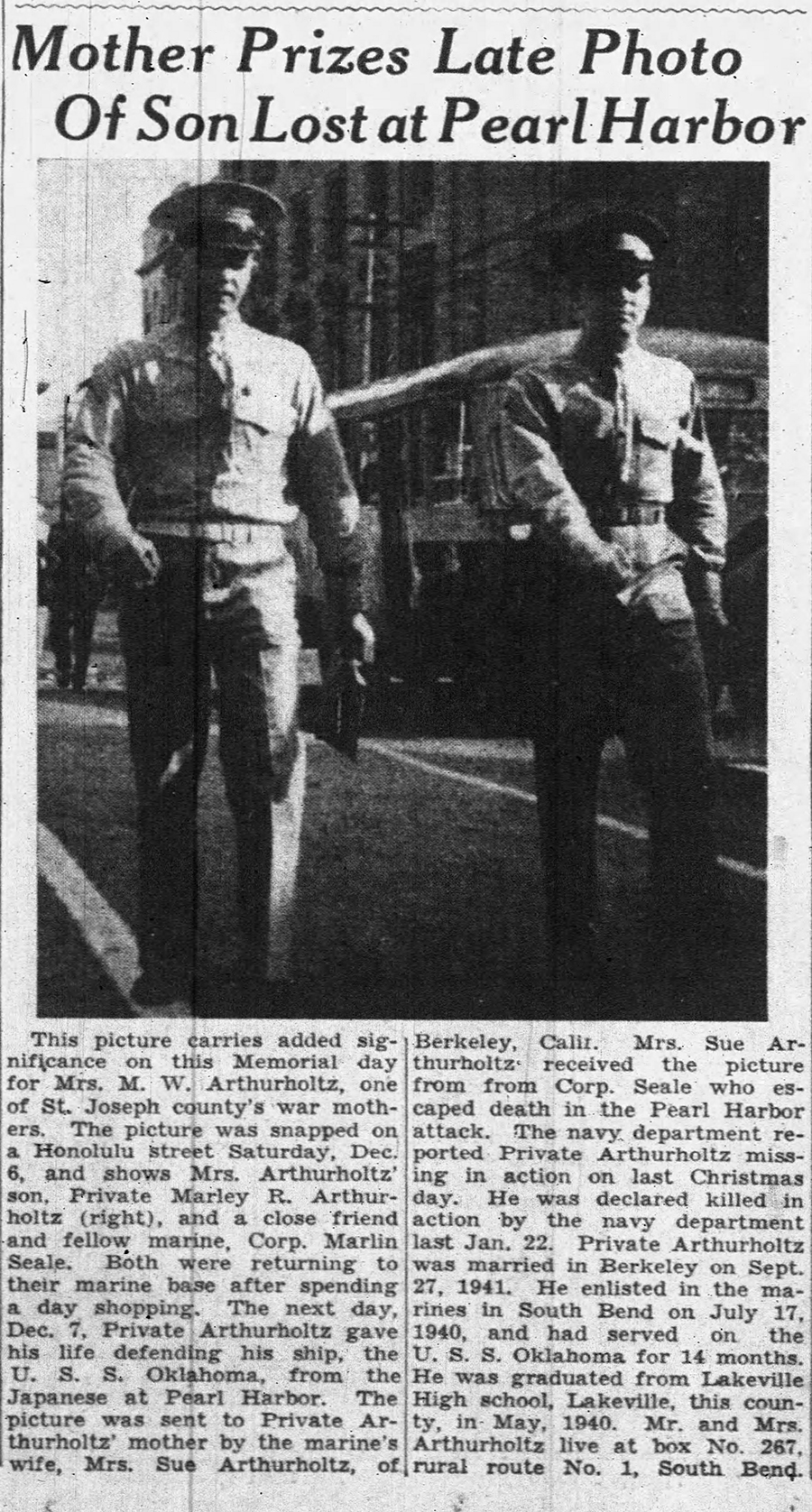
Following a painstaking engineering operation, the Oklahoma was righted and refloated in early 1944. While salvage crews cleaned and removed anything of possible military value, other teams searched through years of accumulated muck for human remains. Navy diver Edward C. Raymer was tasked with taking a civilian reporter aboard the ship:
We reached the third deck, and Burns asked me about dead bodies: how many had been found, what was done with them, how they could be identified. I explained that the medics sorted through all the sludge and debris for bones. Then they placed approximately two hundred bones in a bag, which represented the number in a human body. The bag was sent to the army hospital, where a chaplain performed services for the remains.
According to the Oklahoma’s muster records, four hundred of the crew perished aboard her. I finished by saying I was glad it wasn’t my job to explain to the sailors’ families why their loved ones remained unidentified. The reasons could seem very offensive to them.
Slithering through the ankle-deep filth, Burns caught himself as his foot struck something on the deck. He cried out in revulsion when he found it was part of a human body. “My God, I’ve stumbled over a leg. It even has a shoe on what’s left of the foot.”
– Edward C. Raymer, Descent Into Darkness: Pearl Harbor, 1941, A Navy Diver’s Memoir
The remains recovered from the Oklahoma were buried in fifty-two mass graves in Halawa and Nuuanu Cemeteries on the island of Oahu. At the end of the war, the graves were exhumed with the intent of identifying as many of the dead as possible before reinterment in the National Memorial Cemetery of the Pacific. Dr. Mildred Trotter, one of the anthropologists in charge of the Central Identification Laboratory, was dismayed to note that “common graves consist[ed] of bones of a kind buried together (i.e. one casket was filled with skulls, another with femurs, another with hip bones and so on)” – a strange decision that “added greatly to the difficulty of the undertaking.” Although her technicians made “a very honest effort… to segregate all the remains from the Oklahoma,” Dr. Trotter admitted that it would take “a very long period (years)” and “different circumstances” to fully separate all the remains. Only 49 men could be identified by the end of 1949; the remainder were buried in 46 common graves in Honolulu.
In 2015, an official directive was passed to exhume the graves of the Oklahoma’s final crew. Modern science and DNA analysis provided the “different circumstances” Dr. Trotter’s note required, and more than 100 of the crew have so far been identified. PFC Marley Arthurholtz’s remains were among them; he was officially accounted for on 18 September 2019.
[1] “Family of Marine Lost at Pearl Harbor Continues Fight With U.S. War Bonds,” The South Bend Tribune (30 January 1944). It’s not clear which high school Marley attended; the cited article states he graduated from Riley High School (in South Bend) while an article published after his death mentioned Lakeville High School. The latter seems more likely given that Marley definitely played ball for the Lakeville Trojans.
[2] “Joins Marine Corps,” The South Bend Tribune (20 July 1940).
[3] Sue Ann Linscott Brown (1919-2005) was a native of Berkeley, California; unfortunately, very few details of her relationship with Marley are currently known. A Carson City marriage record and a brief mention in a newspaper article are all the clues. Their marriage was so brief that Marley never changed his primary beneficiary from his parents to his wife.
[4] James Johnson, “‘Okie’ hit first at Pearl Harbor,” The Oklahoman (7 December 1983), online edition accessed 10 October 2019.
[5] “A Letter from Pearl Harbor,” The South Bend Tribune (22 January 1942).




Pingback: Accounted For: Marley R. Arthurholtz – Missing Marines